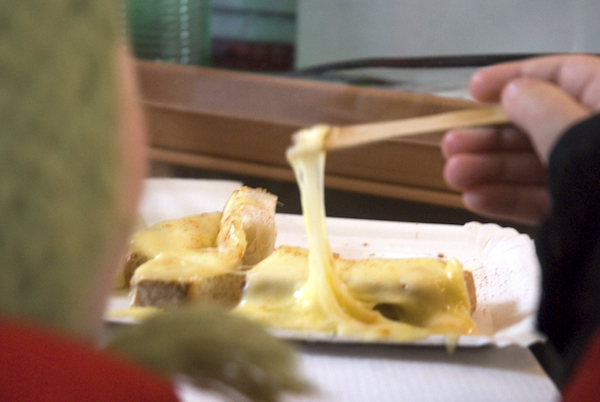Former French President Charles de Gaulle is famous for having declared that it was impossible to govern a country with 246 kinds of cheese… and these days, France is home to far more than that!
It can seem a bit overwhelming to know where to begin, so to help you get started, here are the seven types of French cheese any visitor to Paris – or elsewhere in France – should try to get their hands on.

What's Included
Cindered Goat Cheese
Goat cheeses are produced all over France, but especially in the Loire Valley. Grey-colored ashed or cindered goat cheeses are traditional in this region, where cheesemakers noticed that ash from burned grapevines could neutralize the acidic surface of their cheeses. This makes them more hospitable to sought-after molds that help them develop more flavor.
Not sure where to start? Consider a pyramid-shaped Valençay, a cylindrical Sainte-Maure-de-Touraine, or a round disk of Selles-sur-Cher to explore this creamy cheese’s grassy aroma and flavor.

A Bloomy Rinded Cheese
Brie is perhaps one of France’s most famous cheeses, and for good reason. Brie is a delicious example of the mushroomy, woodsy aromas that can develop when cow’s milk cheeses are allowed to form a “bloom,” or white rind of Penicillium camemberti mold.
Mild Brie de Meaux is a good place to start, though funkier raw milk Camembert or Brie de Melun are great examples of this category too. For something really special, a raw milk, double-cream Chaource from Champagne boasts rich flavor and a creamy, buttery texture.

Pressed Alpine Cheese
Cheeses made in the Alps tend to have dense texture and a rich, nutty flavor that only becomes more pronounced with age. Perhaps the most famous of these is Comté, a cheese sold at anywhere from three to 40 months of age. Comtés aged for 24 or 30 months are relatively easy to find all year long and have an almost caramel color and buttery, hazelnut aromas.
Baked Cheese
Most cheeses in France are meant to be eaten as-is, but some are even better when heated. These include Mont d’Or, usually baked in the wooden box in which it is sold and then drizzled over bread or potatoes. Raclette, meanwhile, is placed on a special apparatus so that only the cut side is melted. It can then be scraped (racler, in French) onto potatoes or charcuterie. Tartiflette is a classic comfort food dish of potatoes, bacon, and cheese topped with a halved Reblochon and baked until bubbly and brown.

Washed Rind Cheese
Not all cheeses smell funky… but orange-hued washed rind cheeses definitely do. The members of this category smell a bit like dirty gym socks, but they taste phenomenal. Try a runny Epoisses from Burgundy, which is washed with Marc de Bourgogne, a local grappa.
Blue Cheese
France is famous for its blue cheeses, which range from milder cow’s milk Fourme d’Ambert to funky, barnyardy Roquefort, made with sheep’s milk. These salty cheeses can often do with a sweet counterpart, either in the form of fruit or sweet Sauternes white wine.

Truffled Cheese
In Paris’ top cheesemongers, you’ll likely find specialty cheeses stuffed with or rolled in all sorts of ingredients from rum-soaked raisins to edible flowers to pistachios. But the most special are undoubtedly truffled cheeses.
These are usually bloomy-rinded cheeses, but might also be pressed Alpine cheeses. Either way, the strong flavors of the truffle and the cheese mean that there’s only one great pairing: a glass of Champagne!

Update notice: This article was updated on August 7, 2023.
Want to make even more delicious memories on your trip to Paris? Join our Wine Tasting in Paris class! Under the guidance of an expert sommelier, you’ll taste your way through five different French wines – and learn what to pair them with!